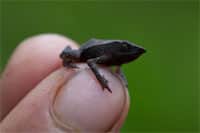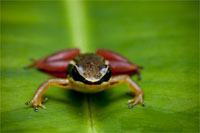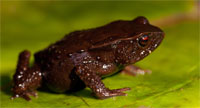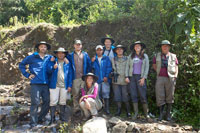Scientists have discovered three amphibian species believed to be new to science.
A team of scientists has discovered three amphibians in western Colombia believed to be new to science. The discoveries include a toad with red eyes, a tiny beaked toad and a rocket frog.
The scientists were working on the Search for Lost Frogs project, supported by Conservation International, and they were looking for the Mesopotamia beaked toad (Rhinella rostrata), which they were unable to find. It has reportedly not been seen since 1914 and is listed as Critically Endangered by the International Union for Conservation of Nature.
The new species were found during the day when they were most active, a behavior which scientists say is unusual among most amphibians, according to Conservation International. The beaked toad, from the genus Rhinella, and the rocket frog, from the genus Silverstoneia, were discovered in the rain forests of the Chocó department in Colombia. The toad with red eyes (for which the genus is unknown) was found in the cloud forests of Chocó.
The beaked toad is considered unusual in that it likely skips the tadpole stage of development, laying eggs on the forest floor that hatch directly into toadlets, according to Conservation International. Scientists found just two individuals, and both were no longer than 2 centimeters. The beaked toad's coloration and head shape cause it to resemble the dead leaves in which it lives.
The new species of rocket frog is a type of dart frog. It lives in and around streams, and rocket frogs carefully carry newly hatched tadpoles on their backs to deposit them in the water to complete their development. Scientists believe the species does not grow larger than 3 centimeters in total length.
The new species of toad with red eyes was found on the forest floor. It is about 3 to 4 centimeters long. Conservation International Amphibian Conservation Specialist Dr. Robin Moore, who led the expedition, said that the bright-red eyes are "highly unusual" in amphibians.
The Search for Lost Frogs, which is taking place in 19 countries on five continents, has led to three species rediscoveries in the past few months, including a Mexican salamander not seen since it was discovered in 1941, a frog from the Ivory Coast not seen since 1967, and another frog from the Democratic Republic of Congo not seen since 1979, according to Conservation International.






